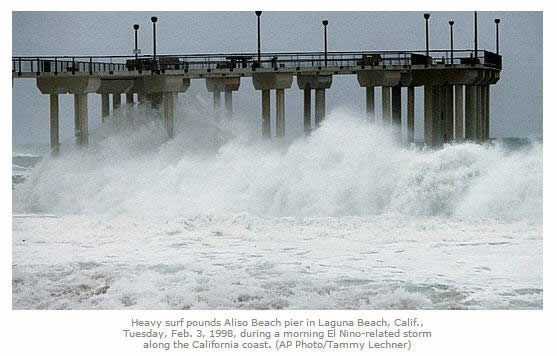
AccuWeather.com-(ENEWSPF)- AccuWeather reports an El Niño pattern has been contributing to drought-busting rain in Texas and the southern Plains. California may be next up for much-needed rain during the winter of 2015-16.
El Niño, which began during the past winter, occurs when ocean water temperatures climb above normal across the central and eastern Pacific, centered around the equator.
According to AccuWeather Meteorologist Ben Noll, along with impacting weather patterns around the globe, an El Niño tends to bring significant rain to the southern part of the United States.
"The pattern of El Niño strengthens the southern storm track across the U.S., especially during the winter, spring and autumn months of the year," Noll said.
How stormy the pattern becomes is generally associated with the strength of El Niño.
"Currently, we have a relatively weak El Niño in progress, but we expect it to become moderate to strong progressing this coming fall and winter," Noll said.
The weak El Niño has been significant enough to contribute to heavy rainfall in a large part of Texas and the southern Plains and sporadic rainfall in California this spring.
"During an El Niño pattern, we tend to get a number of storms in the upper atmosphere that pump moisture into Texas and parts of the Plains," Noll said.
These systems bring multiple rounds of drenching showers and severe thunderstorms.
Portions of Texas have been experiencing severe to exceptional drought since 2012. The extent of drought over Texas and the southern Plains has been shrinking substantially this spring with some locations receiving two to three times their entire May rainfall during the first two weeks of the month.
As the pattern adjusts during the summer, drenching downpours will continue in coastal and northeastern Texas and will expand to more of the Southeast and the lower part of the mid-Atlantic.
Part of Southern California has received drenching rain from the pattern already. Two significant storms have swung through during the first half of May.
San Diego has received more than 2 inches of rain this month, when a typical May brings only about 0.10 of an inch. During late Thursday evening, 1.30 inches of rain fell in one hour.
On average, the bulk of California’s rain falls from November to March, when heavy snow falls on the Sierra Nevada and the ridges in the south.
Despite the recent rains in part of Southern California, other areas of the state have received very little or no rain during May, including Sacramento and San Francisco. While above average, areas from Los Angeles to Riverside and Fresno have received only about 0.50 of an inch of rain thus far this month.
Much more rain and mountain snow is needed across the state on a regular basis to break the drought. Rain is unlikely to swarm over the state from the late spring to the fall, even with an El Niño in progress.
However, as long as El Niño continues into the fall and winter, there is some hope for significant rainfall in California, Noll stated.
One of the strongest El Niño’s on record occurred during the winter of 1997-98, when an average of 20-30 inches of rain fell on California with yards of snow in the Sierra.
A consequence to a strong El Niño during the winter season could lead to powerful storms with not only drenching rain, but also the risk of flooding and mudslides.
Rainfall from the El Niño pattern is likely to diminish during the summer months.
"While we can see a couple more significant upper-level storms through the end of the month, these are likely to become significantly weaker moving forward into June," Noll said.
With a long summer season ahead, evaporation rates will far exceed the rainfall that has fallen or will fall over the next several weeks. As a result, no significant drought relief is likely for California through the summer.
According to AccuWeather Chief Long Range Meteorologist Paul Pastelok, "Drought will worsen and especially farther north into California and the Northwest this summer."
Prior to the winter, the risk of thunderstorms with dry lightning will increase, should the pattern of weak storms continue. A small amount of rain will only spur on the growth of shrub brush, known as Chaparral Broom.
The Chaparral then dries out during the summer and early fall and would provide more dry fuel for wildfires, prior to the winter rain and snow.








